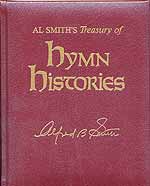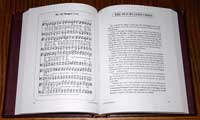 |
|
It is Well with My Soul |
Written: 1873
Authors: Horatio G. Spafford (words) Philip P.
Bliss (music)
|
 |
 |
Inside view
shows sheet music side by side with hymn history. |
Perhaps no other Gospel song has proven
what the longevity of a scripturaly based song can be,
as has "It Is Well With My Soul." Hardly a week goes by
but that I hear it on some radio or television program
or hear it sung in a church. Yet it was written over 100
years ago in 1873.
I'll relay the story of its writing as it was told to
me back in the early 1940's by George C. Stebbins, an
associate of D. L. Moody and a man who knew both Horatio
Spafford and P. P. Bliss, the writers of this song.
Mr.
Spafford was a well-known Christian lawyer, in Chicago,
who also had great holdings in real estate in the fast-growing
frontier town. He had been led into a deeper dedication
of his life and wealth to the Lord through his association
with D. L. Moody and Henry Moorehouse, the English Bible
teacher who had come to Chicago and had preached seven
sermons on John 3:16.
In 1871 the great tragedy of fire struck
Chicago and in a matter of a few hours much of Mr. Spafford's
real estate holdings were nothing but ashes. This proved
a real test for him, but little did he know there would
be a far greater testing for him in the not-too-distant
future.
After the fire, most of young Chicago
lay in ruins. The first building erected on the ashes
was a building built by Mr. Moody called the North Side
Tabernacle. It was at this place that Mr. Spafford kept
himself occupied in helping those whose loss in actual
money was not as great as his; but like the widow who
gave all, they had lost all. He was fortunate for he still
had his law practice, his family, and also had some equity
left.
In November of 1873, some two years after
the fire, many of the schools in Chicago had not yet been
rebuilt and so Mr. Spafford decided that he would take
his family to England where his children could enroll
in an English Academy and not be held back in their education.
Just before they were to leave, a last-minute
business development made it necessary for Mr. Spafford
to remain in Chicago and to send his wife and children
on ahead. He would come later, on another ship.
The Spafford family arrived safely in
New York and boarded the ship Villa de Havre. Soon they
were on their way to England, but in mid-ocean there was
a collision between their ship and an English sailing
ship. The Villa de Havre floundered and sank, taking with
her to the bottom of the ocean most of those onboard,
including the Spaffords' four daughters. Mrs. Spafford
was found barely conscious but clinging to a piece of
the wreckage. While aboard the rescue ship which was taking
her and the other survivors to England, she was able to
draft a short message which was sent to her husband in
Chicago. It read, "Saved, alone."
When Mr. Spafford received this message,
the tragedy of the fire seemed but nothing in comparison
to what this cablegram implied. Money and burned buildings
could be replaced but his children were gone! It was through
these clouds of darkness and despair that there shone,
into the heart of H. G. Spafford, the bright light of
God's promise. God would not forsake him in the trying
hour no matter what the circumstances. Peace like a river
or sorrows like sea billows — with God all is well!
Captured by this thought, Mr. Spafford
quickly penned the words of the song that soon would herald
its way through the Christian church and encourage multitudes.
It would continue doing so for over a hundred years. When
he finished writing the words, Mr. Spafford took the poem
over to a friend and neighbor who also lived on May Street.
His name was P. P. Bliss, the composer who gave the words
a most fitting melody — one that has kept the message
of the song alive and vibrant all of these years." ABS |